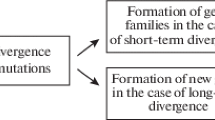Abstract
Eric Davidson had a deep and abiding interest in the role developmental mechanisms played in generating evolutionary patterns documented in deep time, from the origin of the euechinoids to the processes responsible for the morphological architectures of major animal clades. Although not an evolutionary biologist, Davidson’s interests long preceded the current excitement over comparative evolutionary developmental biology. Here I discuss three aspects at the intersection between his research and evolutionary patterns in deep time: First, understanding the mechanisms of body plan formation, particularly those associated with the early diversification of major metazoan clades. Second, a critique of early claims about ancestral metazoans based on the discoveries of highly conserved genes across bilaterian animals. Third, Davidson’s own involvement in paleontology through a collaborative study of the fossil embryos from the Ediacaran Doushantuo Formation in south China.
Similar content being viewed by others
References
Arendt, D., Denes, A. S., Jekely, G., & Tessmar-Raible, K. (2008). The evolution of nervous system centralization. Philosophical Transactions of the Royal Society, B, 363, 1523–1528.
Arendt, D., & Wittbrodt, J. (2001). Reconstructing the eyes of Urbilateria. Proceedings of the Royal Society London, Series B, 356, 1545–1563.
Bengtson, S., & Budd, G. (2004). Comment on “Small bilaterian fossils from 40 to 55 million years before the Cambrian”. Science, 306, 1291a.
Bengtson, S., Cunningham, J. A., Yin, C. Y., & Donoghue, P. C. J. (2012). Merciful death for the “earliest bilaterian,” Vernanimalcula. Evolution & Development, 14, 421–427.
Birnbaum, D., Coulier, F., Pebusque, M.-J., & Pontarotti, P. (2000). “Paleogenomics”: Looking in the past into the future. Journal of Experimental Zoology (Molecular and Developmental Evolution), 288, 21–22.
Bottjer, D. J. (2016). Eric Davidson’s career as a paleontologist. Developmental Biology, 412, S38–S40. doi:10.1016/j.ydbio.2016.01.026.
Bottjer, D. J., Davidson, E. H., Peterson, K. J., & Cameron, R. A. (2006). Paleogenomics of echinoderms. Science, 314, 956–960.
Britten, R. J., & Davidson, E. H. (1969). Gene regulation for higher cells: A theory. Science, 165, 349–357.
Britten, R. J., & Davidson, E. H. (1971). Repetitive and non-repetitive DNA sequences and speculation on the origins of evolutionary novelty. Quarterly Review of Biology, 46, 111–138.
Cameron, A. R., Peterson, K. J., & Davidson, E. H. (1998). Developmental gene regulation and the evolution of large animal body plans. American Zoologist, 38, 609–620.
Carroll, S., Grenier, J., & Weatherbee, S. (2001). From DNA to diversity. Malden: Blackwell Scientific.
Chen, J. Y., Bottjer, D. J., Davidson, E. H., Li, G., Gao, F., Cameron, R. A., et al. (2010). Phase contrast synchrotron X-ray microtomography of Ediacaran (Doushantuo) metazoan microfossils: Phylogenetic diversity and evolutionary implications. Precambrian Research, 179, 221. doi:10.1016/j.precamres.2010.03.001.
Chen, J. Y., Bottjer, D. J., Oliveri, P., Dornbos, S. Q., Gao, F., Ruffins, S., et al. (2004). Small bilaterian fossils from 40 to 55 million years before the cambrian. Science, 305, 218–222.
Chen, J. Y., Oliveri, P., Gao, F., Dornbos, S. Q., Li, C. W., Bottjer, D. J., et al. (2002). Precambrian animal life: Probable developmental and adult cnidarian forms from Southwest China. Developmental Biology, 248, 182–196.
Chen, J. Y., Oliveri, P., Li, C.-W., Zhou, G. Q., Gao, F., Hagadorn, J. W., et al. (2000). Precambrian animal diversity: Putative phosphatized embryos from the Doushantuo Formation of China. Proceedings of the National Academy of Sciences, USA, 97, 4457–4462.
Davidson, E. H. (1986). Gene activity in early development (3rd ed.). Orlando, FL: Academic Press.
Davidson, E. H. (1989). Lineage-specific gene-expression and the regulative capacities of the sea-urchin embryo—a proposed mechanism. Development, 105, 421–445.
Davidson, E. H. (1990). How embryos work—a comparative view of diverse modes of cell fate specification. Development, 108, 365–389.
Davidson, E. H. (1991). Spatial mechanisms of gene-regulation in metazoan embryos. Development, 113, 1–26.
Davidson, E. H. (2001). Genomic regulatory systems. San Diego: Academic Press.
Davidson, E. H. (2006). The regulatory genome. San Diego: Academic Press.
Davidson, E. H., & Erwin, D. H. (2006). Gene regulatory networks and the evolution of animal body plans. Science, 311, 796–800.
Davidson, E. H., Peterson, K. J., & Cameron, R. A. (1995). Origin of bilaterian body plans: Evolution of developmental mechanisms. Science, 270, 1319–1325.
Davidson, E. H., Rast, J. P., Oliveri, P., Ransick, A., Calestani, C., Yuh, C. H., et al. (2002). A provisional regulatory gene network for specification of endomesoderm in the sea urchin embryo. Developmental Biology, 246, 162–190.
De Robertis, E. M., & Sasai, Y. (1996). A common plan for dorsoventral patterning in bilateria. Nature, 380, 37–40.
Donoghue, P. C. J., Bengtson, S., Dong, X. P., Gostling, N. J., Huldtgren, T., Cunningham, J. A., et al. (2006). Synchrotron X-ray tomographic microscopy of fossil embryos. Nature, 442, 680–683.
Dornbos, S. Q., Bottjer, D. J., Chen, I. A., Oliveri, P., Gao, F., & Li, C.-W. (2005). Precambrian animal life: taphonomy of phosphatized metazoan embryos from southwest China. Lethaia, 38, 101–109.
Erkenbrack, E. M., Ako-Asare, K., Miller, E., Tekelenburg, S., Thompson, J. R., & Romano, L. (2016). Ancestral state reconstruction by comparative analysis of a GRN kernel operating in echinoderms. Developmental Genes and Evolution, 226, 37–45. doi:10.1007/s00427-015-0527-y.
Erkenbrack, E. M., & Davidson, E. H. (2015). Evolutionary rewiring of gene regulatory network linkages at divergence of the echinoid subclasses. Proceedings of the National Academy of Sciences, USA, 112, E4075–E4084. doi:10.1073/pnas.1509845112.
Erwin, D. H. (2011). Evolutionary uniformitarianism. Developmental Biology, 357, 27–34.
Erwin, D. H., & Davidson, E. H. (2002). The last common bilaterian ancestor. Development, 129, 3021–3032.
Erwin, D. H., & Davidson, E. H. (2009). The evolution of hierarchical gene regulatory networks. Nature Reviews Genetics, 10, 141–148. doi:10.1038/nrg2499.
Erwin, D. H., Valentine, J. W., & Jablonski, D. (1997). The origin of animal bodyplans. American Scientist, 85, 126–137.
Gao, F., & Davidson, E. H. (2008). Transfer of a large gene regulatory apparatus to a new developmental address in echinoid evolution. Proceedings of the National Academy of Sciences, USA, 105, 6091–6096.
Hinman, V. F., Nguyen, A. T., Cameron, R. A., & Davidson, E. H. (2003). Developmental gene regulatory network architecture across 500 million years of echinoderm evolution. Proceedings of the National Academy of Sciences, USA, 100, 13356–13361.
Hinman, V. F., Nguyen, A., & Davidson, E. H. (2007). Caught in the evolutionary act: Precise cis-regulatory basis of difference in the organization of gene networks of sea stars and sea urchins. Developmental Biology, 312, 584–595.
Lichtneckert, R., & Reichert, H. (2005). Insights into the urbilaterian brain: Conserved genetic patterning mechanisms in insect and vertebrate brain development. Heredity, 94, 465–477.
Lowe, C. J., Terasaki, M., Wu, M. M., Freeman, R. M., Jr., Runft, L., Kwan, K., et al. (2006). Dorsoventral patterning in hemichordates: Insights into early chordate evolution. PLoS Biology, 4, e291.
Miller, D. J., Ball, E. E., & Technau, U. (2005). Cnidarians and ancestral gene complexity in the animal kingdom. Trends in Genetics, 21, 536–539.
Nielsen, C. (2013). Life cycle evolution: Was the eumetazoan ancestor a holopelagic, planktotrophic gastraea? BMC Evolutionary Biology. doi:10.1186/1471-2148-13-171.
Peter, I. S., & Davidson, E. H. (2015). Genomic control processes. Development and evolution. London: Academic Press.
Peterson, K. J., Arenas-Mena, C., & Davidson, E. H. (2000a). The A/P axis in echinoderm ontogeny and evolution: Evidence from fossils and molecules. Evolution & Development, 2, 93–101.
Peterson, K. J., Cameron, A. R., & Davidson, E. H. (1997). Set-aside cells in maximal indirect development: Evolutionary and developmental significance. BioEssays, 19, 623–631.
Peterson, K. J., Cameron, R. A., & Davidson, E. H. (2000b). Bilaterian origins: Significance of new experimental observations. Developmental Biology, 219, 1–17.
Peterson, K. J., & Davidson, E. H. (2000). Regulatory evolution and the origin of the bilaterians. Proceedings of the National Academy of Sciences, USA, 97, 4430–4433.
Pueyo, J. I., & Couso, J. P. (2005). Parallels between the proximal-distal development of vertebrate and arthropod appendages: Homology without an ancestor? Current Opinion in Genetics & Development, 15(4), 439.
Rothenberg, E. V. (2016). Eric Davidson: Steps to a gene regulatory network for development. Developmental Biology, 412, S7–S19.
Scott, M. P. (1994). Intimations of a creature. Cell, 79, 1121–1124.
Shenk, M. A., & Steel, M. A. (1994). A molecular shapshot of the metazoan ‘Eve’. Trends in Biochemical Science, 18, 459–463.
Thompson, J. R., Petsios, E., Davidson, E. H., Erkenbrack, E. M., Gao, F., & Bottjer, D. J. (2015). Reorganization of sea urchin gene regulatory networks at least 268 million years ago as revealed by oldest fossil cidaroid echinoid. Scientific Reports. doi:10.1038/srep15541.
Tweedt, S. M., & Erwin, D. H. (2015). Origin of metazoan developmental toolkits and their expression in the fossil record. In I. Ruiz-Trillo & A. M. Nedelcu (Eds.), Evolution of multicellularity (pp. 47–77). London: Academic Press.
Valentine, J. W., & Campbell, C. A. (1975). Genetic regulation and the fossil record. American Scientist, 63, 673–680.
Valentine, J. W., Jablonski, D., & Erwin, D. H. (1999). Fossils, molecules and embryos: New perspectives on the Cambrian explosion. Development, 126, 851–859.
Wagner, G. P. (2007). The developmental genetics of homology. Nature Reviews Genetics, 8, 473–479.
Wagner, G. P. (2014). Homology, genes, and evolutionary innovation. Princeton, NJ: Princeton University Press.
Xiao, S. H., Yun, Y., Knoll, A. H., & Bartley, J. K. (1998). Three-dimensional preservation of algae and animal embryos in a Neoproterozoic phosphorite. Nature, 391, 553–558.
Yin, Z. J., Zhu, M. Y., Davidson, E. H., Bottjer, D. J., Zhao, F. C., & Tafforeau, P. (2015). Sponge grade body fossil with cellular resolution dating 60 Myr before the Cambrian. Proceedings of the National Academy of Sciences, USA, 112, E1453–E1460. doi:10.1073/pnas.1414577112.
Yuh, C. H., Bolouri, H., & Davidson, E. H. (2001). Cis-regulatory logic in the endo16 gene: Switching from a specification to a differentiation mode of control. Development, 128, 617–629.
Acknowledgements
Earlier versions of this paper were presented at a workshop on “From Genome to Gene” at the Jacques Loeb Centre for the History and Philosophy of the Life Sciences at Ben Gurion University of the Negev in November 2015, and at a memorial symposium for Eric Davidson at Caltech in April 2016. I appreciate the invitation to contribute this paper from Ute Deichmann and Michel Morange. This paper incorporates research funded by the NASA National Astrobiology Institute.
Author information
Authors and Affiliations
Corresponding author
Rights and permissions
About this article
Cite this article
Erwin, D.H. Eric Davidson and deep time. HPLS 39, 29 (2017). https://doi.org/10.1007/s40656-017-0156-z
Published:
DOI: https://doi.org/10.1007/s40656-017-0156-z




